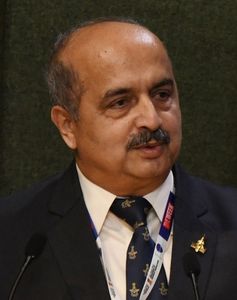FORMER CHIEF OF ARMY STAFF GENERAL MANOJ PANDE
DEFENCE FORCES cannot remain isolated in the business of national security and nation building. To improve outcomes, they must reach out to other ministries, agencies, state governments and even communities.
Currently, while each service interacts with various government agencies on an as required basis, [there could be]a more institutional and structured mechanism.
A pathbreaking reform in human resource management has been implemented by the services in the form of the Agnipath scheme. Its planning and implementation required extensive inter-ministerial consultations and complex coordination. This process must continue.
I also wish to highlight two issues of capability development. First, atmanirbharta, as a strategic imperative for meeting our requirements, has been clearly underscored by recent events. The driver for this has been the government’s initiative, its policies and affirmative actions.
The Indian defence industry has responded well to the demand, challenge and opportunity. While modernisation will demand speed and is the need of the hour, indigenisation will take time. Now, managing this contradiction is the key. It is time we moved away from taking incremental steps to perhaps pole vault in our quest for atmanirbharta. In this regard, the concept of national champions―where Indian businesses are selected by the government as representatives of national effort―needs serious consideration. The concept can be adopted for defence systems where dependencies exist on foreign original equipment manufacturers, and substantial investment in R&D and infrastructure is necessary. Identified industries can be encouraged through grant of special provisions to include subsidies, industry-friendly policies and assured business prospects.
Second, innovation must become the cornerstone of our strategy. We need to give push to fail fast innovation models where R&D programmes are encouraged to take calculated risks. Though a good beginning has been made through the iDEX (Innovations for Defence Excellence) scheme, more needs to be done to make it more agile and responsive.
The academia and research institutes need to step in to contribute to leverage niche and disruptive technologies. It is heartening to see initiatives towards reducing defence procurement and acquisition timelines and bring about changes to the DPP (Defence Procurement Procedure), just as the intended reforms in DRDO meant to address issues of defence R&D and absorption of critical and niche technologies are necessary.
Defence reforms must not be seen as individual steps each service is taking. They must be part of the overall transformation effort.
FORMER CHIEF OF NAVAL STAFF ADMIRAL SUNIL LANBA
IF WE LOOK BACK in history, any country that has been a global or regional power has been so on the back of maritime power. The Indian Navy is the largest resident navy in the Indian Ocean region, but if we don’t have a focused approach on holistic maritime power, this advantage is going to slowly shift away from us. This is the primary reason we need a blue water navy to be counted in the Indian Ocean and now in the larger Indo-Pacific.
Unfortunately, in all these years post independence, we still don’t have a national security strategy. It’s the need of the hour. Only if you have a national security strategy can you have a national defence strategy. So at least we [can] have a document on which the three armed forces can come together to work out what is the military capability required to support the national security strategy. Unfortunately, a number of drafts have been written over the years; I know the last one was written in 2018, but is yet to see the light of day.
Looking at shipbuilding, the largest shipbuilder in the world is China. She has over 50 per cent of the world’s shipbuilding capacity. India’s share is 0.06 per cent and it has only gone down.
As far as India’s private shipbuilding industry goes, [after a long delay], the Indian Navy was finally able to place contracts with private shipbuilders in the country. Unfortunately, in the financial crisis of 2008, all the private shipyards went belly up and not a single ship was delivered to the Navy. So, the Indian Navy is dependent on the DPSUs for shipbuilding contracts. We are captive customers. And between the Indian Navy and the Indian Coast Guard, we don’t have the wherewithal to support the entire shipbuilding industry in the country. There has to be a holistic government policy on the shipbuilding industry in the country.
A majority of ships are being built within the country and the indigenous content has gone up to over 90 per cent. We have come a long way regarding the indigenous content of the ships, but we need to invest more time and money to improve the productivity of shipyards. We had an ambitious target of having a 200-ship Navy by 2027, but that is running way behind schedule.
I have seen the defence procurement manual being modified in my three-year tenure as the chief and chairman, chiefs of staff, twice, and now they are again talking about modifying it. The issue is not the defence procurement model. People in uniform look at timely outcomes, while the bureaucracy focuses on the process. They couldn’t care about the outcome. Damn if the contract takes 15 years to sign. You can imagine the cost escalation in the 15 years and nobody is held accountable. So, if you want a force for the future, a maritime force that has to support India’s regional ambitions, we need a large blue water navy based on three carrier battle groups able to operate freely in the Indian Ocean.
FORMER CHIEF OF AIR STAFF AIR CHIEF MARSHAL V.R. CHAUDHARI
THE FUTURE OF ANY conflict will focus less on firepower and more on the power of information. The ability of any armed force to disrupt the chain of command in any country will emerge as the winner, and not necessarily [who has] larger firepower.
The combination of inexpensive sensors along with big data analytics is going to usher in an era where persistent surveillance becomes a norm. The point here is that while these technologies give us the edge over an adversary, they will also become important targets. So, protection of such decision-making systems is also vital.
Another aspect is lethality. Unfortunately, the lessons we will see coming out of the conflict in the Middle East today is that the potential of these weapons does not cater for conflicts in civilian areas. The Israeli army and the air force had equipped themselves largely with accurate weapons, but which create large amount of collateral damage.
So the area we need to focus on is similar kind of weapons―high-speed, precision attack―with minimal collateral damage. At the same time, when we look at defensive systems, it is not always economical to have kinetic weapons in defence. The rocket that costs $10,000 fired by Hamas is countered by one that costs $5 million.
What we need to focus on probably is directed energy weapons. Probably laser weapons. It may not be too far-fetched to look at such kind of weapons filling our inventory in the near future.
The next area, for hardware, is autonomous systems. As unmanned systems become cheaper, more capable and numerous, [we will see] the power of swarming of drones, which is going to make a huge impact on any battlefield.
But just having an arsenal of new-age technology is not adequate; we need to have the stamina to be able to continue fighting with the weapons that we had in the beginning of a conflict.
Here is where atmanirbharta is going to play a huge role. Not only the capability to manufacture components, but surge capacities to be able to push production at much higher rates. Here technology like 3D printing [comes in].
Also Read
- 'India is preparing to meet multi-domain threats': Rajnath Singh to THE WEEK
- 'India should combine firmness against external threats with compassion, foresight in Kashmir'
- Pahalgam attack: Escalation is imminent, and multiple arms of govt are on the task
- How China can assist Pakistan in aftermath of Pahalgam terror attack
- Why Pakistan army chief Asim Munir is raising tensions with India
- 'Countries fighting terrorism, radicalism quick to identify with India over Pahalgam'
As for software, we may no longer require to [match] force against force if we have adequate software and adequate new technology weapons. There are certain key niche technologies. For example, we talk about drone swarming. The technology to get those drones together as a swarm is easily available within our nation, but we need to protect it at all costs.
It might seem like a paradox, but in the digital era, the value of a human being is only increasing.
For those in uniform, we have to realise that training, educating and honing the skills of the human beings is going to be essential. We need to make everybody digitally fluent at every level in all three services. These are definitely not daunting challenges. They will just require a rethink and understanding of what we call a professional military education in the armed forces.
Selected excerpts from the speeches at THE WEEK Defence Conclave.



